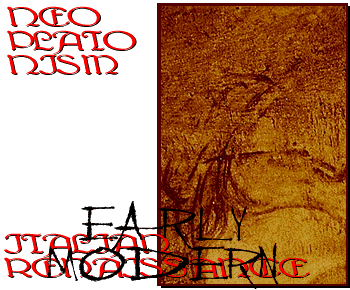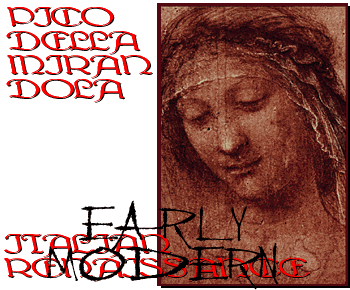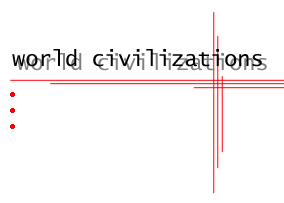

The Platonic Tradition |
There are several misconceptions about the Platonic tradition and its "revival" in the Italian Renaissance. For instance, there really is no solidly coherent body of philosophy that is "Platonic," but rather a series of philosophies openly or implicitly derived from work of the fourth century Athenian philosopher, Plato. In addition, Platonism never really faded out of the Western tradition nor was the Italian Renaissance a rediscovery of Plato; rather, the Italian Renaissance forged new philosophies from Plato and the Platonic tradition in antiquity and the Middle Ages. This new Platonic philosophy not only represented one of the central currents of Renaissance thought, it also had far reaching consequences in the future development of European thought and science. Finally, histories of the Renaissance tend to put Renaissance Platonism in conflict with Aristotelianism and its medieval derivative, Scholasticism. These are oppositional philosophies, or so the histories say, with diametrically opposed aims. The reality is a bit different: the philosophical instinct in the Italian Renaissance was to synthesize thought systems, to find a common, universal philosophy that encompasses a broad range of human thought. The greatest of these synthesizers was the Neoplatonic philosopher, Pico della Mirandola, who attempted to synthesize Platonism, Aristotelianism, Stoicism, Hebrew thought, Jewish mysticism, Arabic philosophy, and a whole host of others into a single philosophical system. |
|
The dialogues and teaching of Plato form the ground on which the Platonic tradition is built. Plato ran an academy for philosophy in Athens during the first half of the fourth century BC. As instructional exercises, he composed a series of dialogues with Socrates as the main protagonist over such questions as what is virtue?, can virtue be taught?, what is love?, what is justice?, and so on. The foundation of Plato's thought was that the universe consists of two realms: a realm of appearance and a realm of eternal, abstract forms. While the world of appearances (the world you and I live in) constantly changes and so affords no possibility of certain knowledge, the world of forms is always static. For instance, while a horse will cease to be a horse if you run over it with eighteen wheeler, the "form of a horse," that is, the intellectual category of "horse" by which we understand horses to be differentiable from other things, always remains the same, even if we run over every horse in existence. In this realm of forms (the Greek word is "idea"), the highest levels of existence and knowledge is mathematics, and the very highest form or idea is the "form of the good." |
|
The Platonic tradition continued not through these dialogues but through the activities of Plato's Academy, which lasted until 539 AD, almost a thousand years of intellectual activity and ferment. The philosophy of Plato changed dramatically over the centuries and the general outline of that change is described by categorizing the Platonic tradition into two categories: Middle Platonism and Neoplatonism (meaning "new Platonism"). The most significant and far-reaching innovation of the Middle Platonists was the development of the view that the eternal forms or ideas that underly the world of appearances are the thoughts of some single god or divinity. This means that all abstract categories and all mathematics are closer to the mind of God than anything else. The Neoplatonists, on the other hand, sought to combine Platonism with the other major philosophies of antiquity, such as Stoicism, Aristoteleanism, and various theologies. In this respect, the Neoplatonist activity was more similar to that of the philosphers of the Han synthesis in China, who also sought to systematically reconcile the myriad of contending philosophical schools. The two most important Neoplatonic philosophers, Plotinus and Proclus, were active in the third century AD, and between them they effected the most systematic synthesis of Roman and Greek thought ever attained in the European tradition. Their most important innovation was the fusion of the Platonic forms with Aristotle's concept of an ordered an hierarchical universe. In the Neoplatonic scheme of things, the top of the hierarchy of the universe was one god, called "the One," and that all the lower levels were "emanations" from God. The lowest level of the universe was this world; since it is the farthest from the One it is both less real than the rest of the universe and less like God. |
|
During the Middle Ages, the Platonic tradition survived in three distinct traditions: the European tradition, the Byzantine tradition, and the Islamic tradition. In Europe, Neo-Platonism never really died out because it formed the philosophical heart of the thought of Augustine and Boethius. Many of the standard Neoplatonic ideas, such as the existence of higher ideas in the mind of God and the reflection of those ideas in the real world were standard aspects of medieval thought. The knowledge of Plato was never lost; Plato's most thorough description of the structure of the universe, the Timaeus, was preserved and read throughout the middle ages in a Latin translation.
The Islamic tradition, on the other hand, far preferred Aristotle over Plato. The Islamic scholars never ignored Plato but gave far greater preference to the empirical and qualitiative philosophy of Aristotle. When the Islamic tradition intersected with the European tradition in the twelfth century, Europeans got a heavy dose of Aristotle with a correspondingly low dose of Plato. As a result, the European preference for the Platonic tradition, reflected in the predominance of Augustine, began to fade. Of all the medieval Platonic traditions, the most dynamic was the Byzantine tradition. The Byzantines carried on the Neoplatonic speculations about the divine ideas and their relation to the physical world. Most importantly, the Byzantine Neoplatonists carried on the work of synthesizing philosophies—the most crucial of these was the synthesis of Platonism with Christianity. In the fourteenth and fifteenth centuries, the most active of these Neoplatonists was Gemistus Pletho. He is most significant for the Italian Renaissance for he visited Italy and introduced the Italians to Byzantine Neoplatonism. Pletho also introduced the Italians to the notion that the philosophical systems of Plato and Aristotle were in conflict with one another; a large part of European thought during the Renaissance would involve spelling out this conflict. For all practical purposes, then, the Neoplatonism of the Italian Renaissance continues these three traditions. The Neoplatonists inherit the Augustinian and Boethian synthesis of Platonism with Christianity and many are avowed Augustinians. The Islamic tradition had taught Europeans to prize empiricism, logic, hierarchy, and qualitative knowledge in relation to the "divine ideas." Finally, the strongest influence were the Byzantine traditions which continued the Neoplatonic speculation into the mind of God and, more importantly, continued the tradition of synthesizing philosophical traditions. |
Renaissance Platonism |
Renaissance Platonism cannot really be easily considered as a school or even a coherent movement. Unlike humanism or Aristoteleanism, it was not a program of education and so did not constitute normal studies, nor did it ever become a program of study or curriculum. Aside from the Academy founded by Marsilio Ficino and Cosimo de'Medici, it had only the slimmest of institutional support as a distinct discipline. Only a few philosophers, such as Cardinal Bessarion, Nicholas Cusanus, Marsilio Ficino, and Pico della Mirandola, can be unabashedly classified as "Neoplatonists." In the history of ideas, Renaissance Neoplatonism is more important for its diffusion into a variety of philosophies and cultural activities, such as literature, painting, and music.
The humanists, beginning Petrarch, associated themselves in part with Platonic philosphy as a reaction against Aristoteleanism, though the early humanists knew little or nothing about Platonism. It wasn't until the arrival of Byzantine philosophers, most importantly John Chrysolas and Pletho, that the Italians were really introduced to the entire corpus of Platonic works. The first to undertake translating and transmitting Plato to the rest of Europe was Cardinal Bessarion, who, as a student of Pletho when he visited Italy, had thoroughly internalized Platonic ideas. This translation project, begun by Bessarion, would be completed a few decades later when Ficino undertook the herculean task of translating all of Plato's works into Latin. |
|
The first highly influential Neoplatonic philosopher in the Italian Renaissance was Nicholas Cusanus who developed a rich and complex view of the universe and human knowledge. Among his most important and far-reaching ideas was the idea that mathematical knowledge was always absolutely certain knowledge; as such, the mathematical sciences were higher than all other sciences, including the qualitative empiricism of Aristotle. Cusanus also argued that their was one single, archetypal idea in the mind of God and that this idea is present in every other idea and in every physical object. With the proper understanding, one could arrive at this archetypal idea by studying any object whatsoever. This is a remarkably similar conclusion to that arrived at by the School of Principle in Chinese Neo-Confucianism. The critical difference between Cusanus and the Chinese Neo-Confucianists was that Cusanus advocated a mathematical approach while Neo-Confucianism led to a qualitative empirical science such as that practiced by Aristotle. |
Marsilio Ficino |
The most important of the Renaissance Neo-Platonists was Marsilio Ficino, who developed original and highly influential ideas from Plato and Neoplatonism. Ficino was an active and dynamic mind; as the founder of the Academy in Firenze under the auspices of Cosimo de'Medici, he, more than any other person in the Renaissance, was responsible for its widespread diffusion. The Academy resembled no academic organization that you might think of; it was part discussion group and part literary club. Discussions were wide ranging and activities included poetry and games. The overall character of the Academy, however, was syncretic and synthetic. The members of the Academy believed at some level that all human thought and arts could be discussed in a common language based on Neoplatonic ideas.
Ficino translated all of Plato's dialogues into Latin and produced a number of commentaries, but his most important and systematic work was Platonic Theology , in which he outlines Neoplatonism and synthesizes it with other philosophical systems, in particular, Christianity. Ficino's philosophy is based on one central doctrine: the human soul is immortal and the center of the universe. It is the only thing that sits midway between the abstract realm of ideas and the physical world—as such, it is the mediator between these two worlds: All things beneath God are but single things, but the soul can truly be said to be all things . . . For this resaon, the soul is called the center of creation and the middle term of all things in the universe, the entirety of the universe, the face of all things, and the binding and joining center of the universe.This special, central position in the universe made humanity the most dignified of all objects in creation; Ficino's emphasis on the dignity of humanity was derived from humanistic currents. From the standpoint of religion, Ficino was a syncretic in that he believed that all the world's religions could be related to one another. At the heart of every religion was a belief in the one God and the variety of relgions was not a bad thing but rather an expression of the complexity and beauty of God worshipped in all his infinite aspects. Of course, Christianity was a more complete religion. Ficino believed that the purpose of human life was contemplation. The ultimate goal of human life was to be reunited with God, at least in an intellectual sense. This goal, according to Ficino, was realized through contemplation. At first, the human mind removes itself from the outside, physical world, and thinks about abstract ideas concerning knowledge and the soul. As it rises in knowledge it eventually reaches a point where it can arrive at an unmediated vision of God itself—this last stage would occur only after death and the immortality that the soul would enjoy would be an eternity of this vision of God. From this program, Ficino developed a concept he called Platonic love, which had far-reaching consequences in the history of love and social reality in the European tradition. While Ficino believed that the human soul pursued contemplation more or less in isolation, he acknowledged that human beings were fundamentally social. When the spiritual relationship between God and the individual, sought through contemplation, is reproduced in a friendship or love with another person, that constitutes for Ficino spiritual or Platonic love. In other words, when the love and spiritual activity in a friendship mirrors the love for God, then the two individuals have attained the highest type of friendship that they can. Ficino did not condemn sexuality or erotics nor deny that Platonic love was only possible outside sexual relations; his only concern was the nature of the spiritual bond between two people. |
Consequences |
The two most influential aspects of Neoplatonism for Western culture were its emphasis on the priority and certainty of mathematics and Ficino's doctrine of Platonic love.
While Renaissance artists, thinkers, and other cultural producers only picked up Neoplatonism in part, the doctrine of Platonic love diffused quickly all throughout the culture. It significantly changed the European experience of sexual love which, since antiquity, had always been closely related erotics and physical attraction. Suddenly writers, artists, poets, philosophers, and women's communities began discussing sexual love in terms of spiritual bonds, as reflecting the relationship between the individuals and God. Platonic love also gave homosexual erotics a new language. While homosexuality was extremely common in the middle ages, it wasn't really regarded as an identity characteristic, as we do today. When a man had sex with another man, he was a sodomite for as long as the act took place. After that, he was someone who committed sodomy; homosexuality as a steady state did not really exist. The language of Platonic love, however, gave the Italians a language with which to define non-sexual male-male relationships. Once understood in spiritual terms, male-male sexual relationships could now be discussed in the same terms: in the Italian Renaissance, the language of male-male friendship and male-male erotics became the same. This language is still a key element in the modern debates of homosexuality and lesbianism. Nicholas of Cusanus expanded the Platonic argument that mathematics were a form of certain knowledge to the radical thesis that mathematics represented the divine ideas. This extreme position, accepted by Neoplatonists (except of Pico), eventually became the basis for a new form of science. Through the high middle ages, scientific inquiry was dominated by the qualitative, empirical science of Aristotle combined with the doctrine from the Arabic philosopher, Averroes, that inquiry into the physical world should never include speculation about God or any other kind of metaphysics. In distinction to this, the Neoplatonists that the physical world was fundamentally mathematical and that a knowledge of that mathematics would provide access to the divine mind. The most famous advocate of this scientific position was Joahnnes Kepler and later, Galileo Galilei. Their story is told in the chapter on the so-called scientific revolution, but we can look forward at the conclusion of this essay. Kepler, working in the first half of the sixteenth century, believed that the mathematics of the universe was the truth of the universe. Until Kepler, astronomers and astrologers believed that the qualitative understanding of the universe superseded the quantitaive understanding of the universe. The Ptolemaic universe, which was a mathematical system for describing the movements of the heavenly bodies in relation to the earth as the center of the universe, had long been regarded as a nearly insane mathematical system. That wasn't the point, though. Even though the Ptolemaic universe didn't make much sense mathematically, it served its purpose in that it provided the math to successfully predict movements of the heavenly bodies. For Kepler, the math of the movements of the stars and planets was the movement of the stars and planets; the most rational mathematical universe was one in which the planets and stars orbitted the sun. This, because it was the most rational mathematics, represented the physical truth. This is a unique reorientation of mathematics to physical phenomena and remains the standard world view of European physics. While Galileo's relationship to Neoplatonism is controversial, he seems to have inherited from Neoplatonism this same view of mathematics. The fundamental truth of the universe, as Galileo saw it, was mathematical. Only when our understanding of the universe corresponded to the math of the universe could we say that we understood the universe. In the dogmatic throes of the counter-Reformation, the church wasn't willing to accept some of the conclusions that resulted from this viewopint, such as understanding that the sun is the center of the solar system. It wasn't until Newton that this mathematical view of the universe finally took hold and perpetually changed the face of European science. So, the next time you walk into a physics course, remember, the fundamental understanding of the universe that they're using has its origins in Renaissance Neoplatonism. Richard Hooker |


